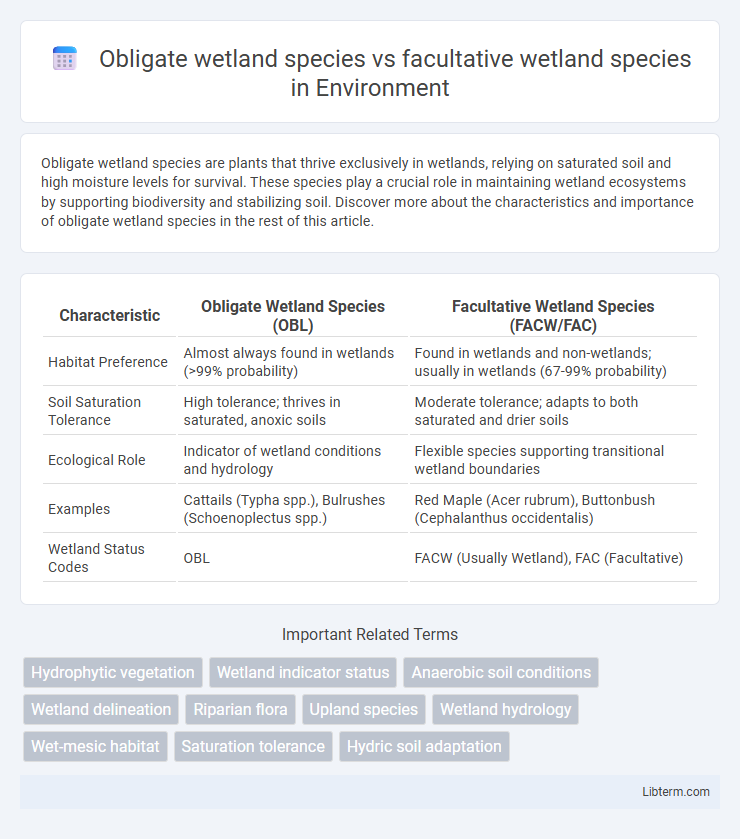Obligate wetland species are plants that thrive exclusively in wetlands, relying on saturated soil and high moisture levels for survival. These species play a crucial role in maintaining wetland ecosystems by supporting biodiversity and stabilizing soil. Discover more about the characteristics and importance of obligate wetland species in the rest of this article.
Table of Comparison
| Characteristic | Obligate Wetland Species (OBL) | Facultative Wetland Species (FACW/FAC) |
|---|---|---|
| Habitat Preference | Almost always found in wetlands (>99% probability) | Found in wetlands and non-wetlands; usually in wetlands (67-99% probability) |
| Soil Saturation Tolerance | High tolerance; thrives in saturated, anoxic soils | Moderate tolerance; adapts to both saturated and drier soils |
| Ecological Role | Indicator of wetland conditions and hydrology | Flexible species supporting transitional wetland boundaries |
| Examples | Cattails (Typha spp.), Bulrushes (Schoenoplectus spp.) | Red Maple (Acer rubrum), Buttonbush (Cephalanthus occidentalis) |
| Wetland Status Codes | OBL | FACW (Usually Wetland), FAC (Facultative) |
Introduction to Wetland Species
Obligate wetland species are plants that almost exclusively occur in wetlands, indicating a strong dependence on saturated soil conditions for survival and growth. Facultative wetland species thrive in both wetland and non-wetland environments, demonstrating greater ecological flexibility. Understanding the distribution and classification of these species aids in wetland delineation, conservation efforts, and ecosystem assessment.
Defining Obligate Wetland Species
Obligate wetland species are plants that occur almost exclusively in wetland environments, with a probability greater than 99% of being found in wetlands under natural conditions. These species have specific adaptations allowing them to thrive in saturated soils and anaerobic conditions typical of marshes, swamps, and bogs. In contrast, facultative wetland species can grow in both wetland and non-wetland habitats, showing more ecological flexibility.
Characteristics of Obligate Wetland Species
Obligate wetland species are plants that occur almost exclusively in wetland environments, with a probability greater than 99% of being found in wetlands under natural conditions. These species possess specialized adaptations such as aerenchyma tissue, enabling oxygen transport in waterlogged soils, and shallow root systems tolerant of prolonged flooding. Their ecological role includes stabilizing wetland soils, supporting hydrophilic wildlife, and contributing to nutrient cycling in saturated habitats.
Overview of Facultative Wetland Species
Facultative wetland species are plants that typically occur in wetlands but can also thrive in non-wetland areas, displaying flexible habitat adaptability. These species have an estimated probability of 34-66% for being found in wetlands under natural conditions, serving as important ecological indicators for wetland boundaries. Their ability to tolerate varying moisture levels makes facultative wetland species crucial for transitional zones between upland and wetland ecosystems.
Key Differences: Obligate vs Facultative Wetland Species
Obligate wetland species are plants that occur almost exclusively in wetlands, with a probability greater than 99% of being found in such environments, indicating their strong adaptation to saturated soil conditions. Facultative wetland species display more ecological flexibility, typically found in wetlands 67% to 99% of the time but capable of surviving in non-wetland habitats as well. This distinction highlights obligate species as critical indicators of wetland ecosystems, while facultative species serve as ecological bridges between wetland and upland zones.
Ecological Roles in Wetland Ecosystems
Obligate wetland species, such as cattails (Typha spp.), play a crucial ecological role by dominating wetland environments and providing essential habitat and food sources for diverse aquatic wildlife. Facultative wetland species, like red maple (Acer rubrum), contribute to ecosystem resilience by thriving in both wetland and upland areas, supporting biodiversity and nutrient cycling across ecological gradients. Together, these species maintain wetland structure, enhance water filtration, and stabilize soil, promoting overall ecosystem health.
Adaptations to Wetland Environments
Obligate wetland species possess specialized adaptations such as aerenchyma tissues for oxygen transport and shallow root systems to survive prolonged flooding, ensuring efficient respiration in anoxic soil conditions. Facultative wetland species exhibit greater physiological flexibility, enabling them to tolerate both saturated and drier soils by modulating root morphology and stomatal conductance according to moisture availability. These adaptive strategies reflect the evolutionary divergence between species strictly dependent on wetland habitats and those capable of thriving across varying hydrological gradients.
Importance in Wetland Identification and Delineation
Obligate wetland species, found almost exclusively in wetland environments, serve as critical indicators for accurate wetland identification and delineation due to their strong affinity for saturated soils. Facultative wetland species, capable of growing in both wetland and non-wetland conditions, provide valuable information on the transitional zones and the hydrologic gradients within wetland boundaries. Together, these species help establish precise wetland boundaries by reflecting varying degrees of hydrologic influence and vegetation adaptation.
Conservation Considerations for Wetland Species
Obligate wetland species, which occur almost exclusively in wetland environments, require stringent conservation measures to preserve their critical habitats and maintain hydrological conditions. Facultative wetland species, adaptable to both wetland and upland areas, benefit from habitat connectivity and buffer zones that support their ecological flexibility while preventing habitat fragmentation. Effective wetland conservation plans prioritize protection of obligate species' core habitats and implement landscape-scale approaches to accommodate facultative species' range shifts due to environmental changes.
Conclusion: Implications for Wetland Management
Obligate wetland species, which almost exclusively occur in wetlands, indicate high wetland integrity and are critical for accurate wetland delineation and conservation efforts. Facultative wetland species, found in both wetland and non-wetland environments, reflect transitional zones and can inform adaptive management strategies that address both wetland preservation and buffer zone maintenance. Understanding the distinct ecological roles and habitat preferences of these species enhances wetland restoration, monitoring, and regulatory compliance.
Obligate wetland species Infographic

 libterm.com
libterm.com